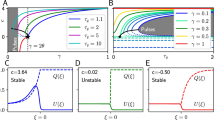Abstract
This report calls attention to the magnitude and pervasiveness of hysteresis in the coding from length to afferent discharges in crayfish stretch receptor organs (SRO's). The influence of previous lengths on the rate that corresponded to a particular length L was manifest by a substantial excess of that encountered when L was arrived at from a shorter value over that when arrived at from a longer one. Hysteretic loops were present under dynamic conditions when length was modulated quasi-sinusoidally in the length vs. rate Lissajous plots of both the slowly and the fast-adapting organs (SAO, FAO), either not perturbed or perturbed. Loops became narrower with increasing frequency (except for when 1 to 1 locking appeared, Diez Martínez and Segundo, 1983). Hysteretic loops were present under static conditions when length changes were step-like, and fully adapted rates were noted in the SAO and in the perturbed FAO.
Earlier reports suggest that hysteresis reflects jointly at least mechanical and electrogenic factors in the “length-to-local dendritic effects” and in the “generator potential to discharge” stages.
Several models, either mechanical or mathematical, reveal hysteretic behavior. Detailed analysis has not been performed except for one instance (Chua and Bass, 1972) where, for example, loop-narrowing at higher frequencies occurs only with certain weighting functions whose physiological significance is as yet obscure.
Hysteresis may be more widespread than suspected in sensory (and perhaps other) systems: it involves a multi-valuedness that raises the issue of how central mechanisms infer stimulus magnitude retrospectively from the discharge.
Similar content being viewed by others
References
Alvarez Buylla, R., Ramírez de Arellano, J.: Local responses in Pacinian corpuscles. Am. J. Physiol. 172, 237–244 (1953)
Babcock Gove, P.: Third new international dictionary of the english language — unabridged. Springfield, MA: Merriam 1981
Borsellino, A., Poppele, R.E., Terzuolo, C.A.: Transfer functions of the slowly adapting stretch receptor organ ofcrustacea. In: Cold Spring Harbor Symposium on Quantitative Biology. 30, 581–586 (1965)
Brown, M.C., Stein, R.: Quantitative studies on the slowly adapting stretch receptor of the crayfish. Kybernetik 3, 175–181 (1966)
Buño, Jr., W., Bustamante, J., Fuentes, J.: White noise analysis of pacemaker-response interactions and non linearities in slowly-adapting crayfish stretch receptor. J. Physiol. 350, 55–80 (1984)
Buño, W. Jr., Fuentes, J., Segundo, J.P.: Crayfish stret-receptor organs: effects of length-steps with and without perturbations. Biol. Cybern. 31, 99–110 (1978)
Chaplain, R.A., Michaelis, B., Coenen, R.: Systems analysis of biological receptors. I. Quantitative description of the input-output characteristics of the slowly-adapting stretch receptor on the crayfish. Kybernetik 9, 85–95 (1971)
Chua, L.O., Bass, S.C.: A generalized hysteresis model. IEEE Trans. CT-19, 36–48 (1972)
Diez Martínez, O.: Fast adapting stretch-receptor. Periodic and steady-state stimulation with and without perturbation. University of California, Los Angeles. Doctoral Thesis, 1981
Diez Martínez, O., Kohn, A.F., Segundo, J.P.: Pervasive locking, saturation, asymmetric rate-sensitivity and double-valuedness in crayfish stretch receptors. Biol. Cybern. 49, 33–43 (1983)
Eyzaguirre, C., Kuffler, S.W.: Processes of excitation in the dendrites and in the soma of single isolated sensory nerve cells of the lobster and crayfish. J. Gen. Physiol. 39, 87–119 (1955)
Fischer, W., Michaelis, B.: Frequency domain analysis of the dynamic properties of the encoder in the slowly-adapting crayfish stretch receptor neuron. Acta Biol. Med. Ger. 37, 1665–1680 (1978)
Fohlmeister, J.F.: Excitation parameters of the repetitive firing mechanism from a statistical evaluation of nerve impulse trains. Biol. Cybern. 34, 227–232 (1979)
Fohlmeister, J.F., Poppele, R.E., Purple, R.L.: Repetitive firing: a quantitative study of feedback in model encoders. J. gen. Physiol. 69, 815–848 (1977a)
Fohlmeister, J.F., Poppele, R.E., Purple, R.L.: Repetitive firing: quantitative analysis of encoder behavior of slowly adapting stretch receptor of crayfish and eccentric cell of Limulus. J. Gen. Physiol. 69, 849–877 (1977b)
Fujita, Y., Rosenberg, J., Segundo, J.P.: Activity of cells in the lateral vestibular nucleus as a function of head position. J. Physiol. 196, 1–18 (1968)
Granit, R., Kernell, D., Shortess, G.K.: The behavior of mammalian motoneurones during long-lasting orthodromic, antidromic, and transmembrane stimulation. J. Physiol. 169, 743–754 (1963)
Hartline, D.K.: Simulation of phase-dependent pattern changes to perturbations of regular firing in crayfish stretch receptor. Brain Res. 110, 245–254 (1976)
Krnjevic, K., van Gelder, N.M.: Tension changes in crayfish stretch receptors. J. Physiol. 159, 310–325 (1961)
Mountcastle, V.B., Poggio, G.F., Werner, G.: The relation of thalamic cell response to peripheral stimuli varied over an intensity continuum. J. Neurophysiol. 26, 807 (1963)
Nakajima, S., Onodera, K.: Membrane properties of the stretch receptor neurones of crayfish with particular reference to mechanisms of sensory adaptation. J. Physiol. (London) 200, 161–185 (1969a)
Nakajima, S., Onodera, K.: Adaptation of the generator potential in the crayfish stretch receptors under constant length and constant tension. J. Physiol. (London) 200, 187–204 (1969b)
Segundo, J.P., Diez Martínez, O.: Stretch receptor responses to sinusoidal stimuli depend strongly on modulation depth and background length. Biol. Cybern. (in press)
Sydness, G., Walløe, L.: Transfer properties of the slowly-adapting stretch receptor of the crayfish abdomen. Acta Physiol. Scand. 109, 439–445 (1980)
Tasaki, I.: Physiology and electrochemistry of nerve fibers. New York: Academic Press 1982
Teorell, T.: A biophysical analysis of mechano-electrical transduction. In: Handbook of sensory physiology, Vol. I. Loewenstein, W., ed. Berlin, Heidelberg, New York: Springer 1971, Chap. 10
Terzuolo, C.A., Washizu, W.: Relation between stimulus strength, generator potential and impulse frequency in stretch receptor of crustacea. J. Neurophysiol. 25, 56–65 (1962)
Vibert, J.F., Segundo, J.P.: Slowly-adapting stretch-receptor organs: periodic stimulation with and without perturbations. Biol. Cybern. 33, 81–95 (1979)
Vidal, J., Jeannerod, M., Lifshitz, W., Levitan, H., Rosenberg, J., Segundo, J.P.: Static and dynamic properties of gravity-sensitive receptors in the cat vestibular system. Kybernetik 9, 205–215 (1971)
Author information
Authors and Affiliations
Additional information
Supported by funds from the Brain Research Institute and by a scholarship to ODM from the Departmento de Becas, Universidad Nacional Autónoma de México (UNAM)
Rights and permissions
About this article
Cite this article
Segundo, J.P., Martínez, O.D. Dynamic and static hysteresis in crayfish stretch receptors. Biol. Cybern. 52, 291–296 (1985). https://doi.org/10.1007/BF00355750
Received:
Issue Date:
DOI: https://doi.org/10.1007/BF00355750




